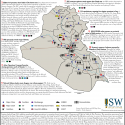 |
 |
Iraq Situation Report: March 1 - 7, 2016

Iranian-backed Iraqi Shi’a militias spearheaded major operations to recapture desert terrain west of Samarra and Tikrit in Salah al-Din Province. The operation, announced and initiated by the Joint Operations Command on March 4, involves the Iraqi Security Forces (ISF) and Popular Mobilization, and aims to secure the Jazeera desert area northwest of Baghdad and prevent its use by ISIS as a support zone. ISIS has freedom of access and attack in these areas which it uses to target Baghdad, areas west of Samarra, and Baiji. The Popular Mobilization Commission (PMC) also announced the operation, and the PMC deputy chairman, U.S.-designated terrorist Abu Mahdi al-Muhandis, played a leading role in coordinating the operation. Major Iranian proxy militias, including Kata’ib Hezbollah and Asa’ib Ahl al-Haq, deployed forces as part of the operation, and the PMC spokesperson denied that Coalition airstrikes played any role; the Coalition reported no airstrikes in Salah al-Din during the two-day operation. The Popular Mobilization and security forces lack the capacity to hold desert terrain and prevent ISIS from freely accessing the area, however.
The Popular Mobilization and security forces have struggled to secure the Thar Thar desert area north of Fallujah, and multiple militia-led clearing operations have failed to secure these areas since June 2015. The high-profile militia operation bolsters the Iranian proxy narrative that the Popular Mobilization is the essential ally of the Iraqi government in the fight against ISIS. It also underscores the need for the U.S. and the Coalition to increase its support for the Iraqi Security Forces (ISF) in order for the ISF to successfully recapture and secure territory from ISIS as a means of undermining the militia narrative. Meanwhile, an ISIS attacker detonated an explosives-laden fuel tanker at a checkpoint north of Hillah in Babil Province on March 6, killing more than 60 people and wounding more than 70 others. It was the first successful spectacular attack in Babil since 2013, and a provincial security official called it the largest attack in Babil to date. ISIS last detonated a VBIED in Babil in August 2015 in a failed attack that caused minimal casualties. The attack demonstrates that ISIS has the logistical capacity to launch spectacular attacks in Babil, a province that ISIS has not controlled terrain in since October 2014. The March 6 attack is likely a continuation of a series of suicide vest attacks between February 25 and February 29 intended to incite sectarian tensions and force the Popular Mobilization and ISF to redeploy for defensive measures away from forward operations.